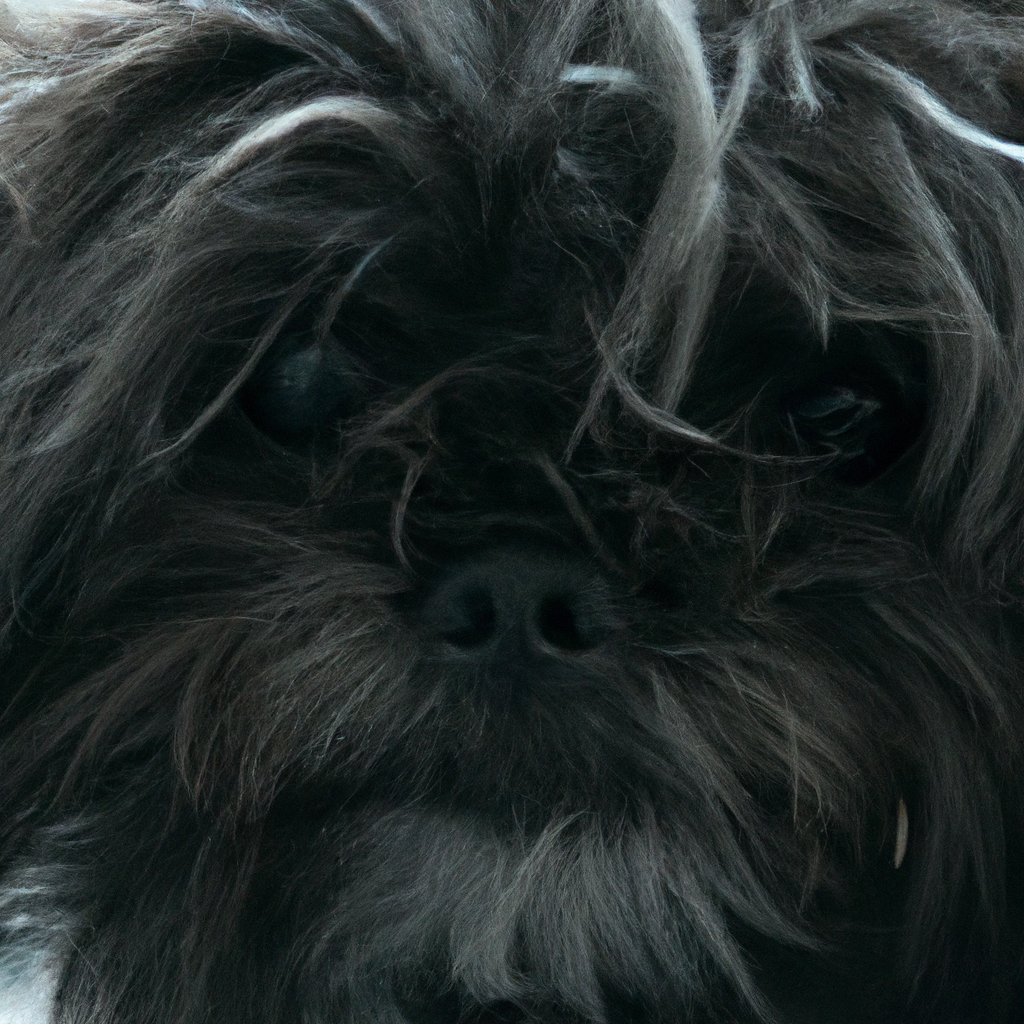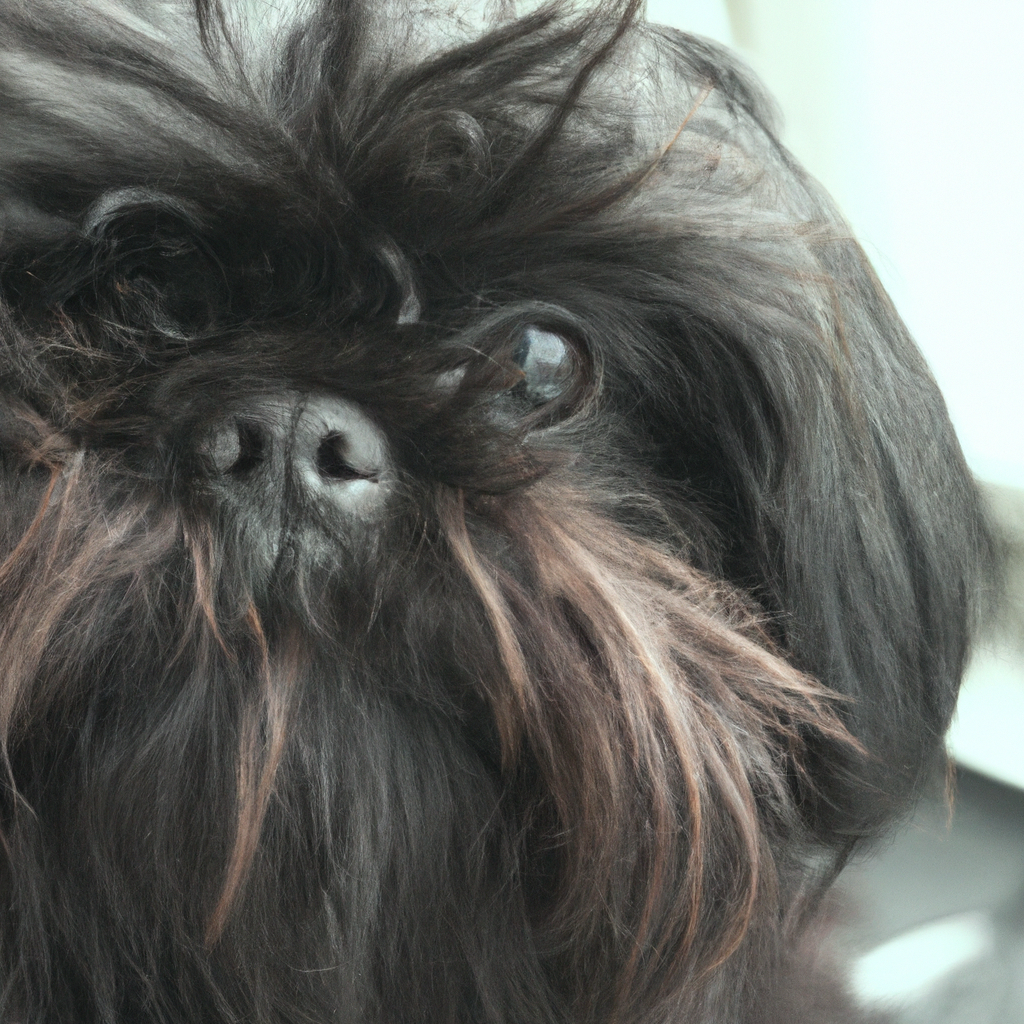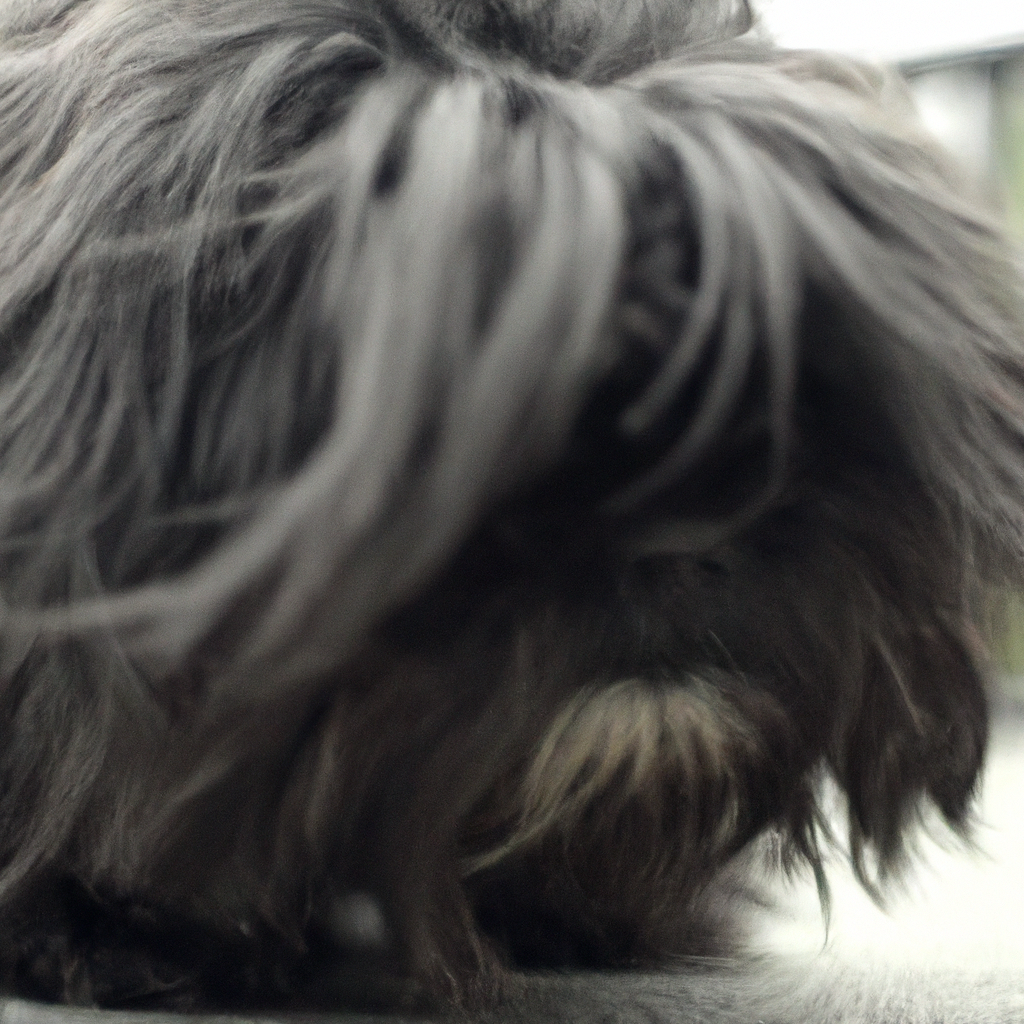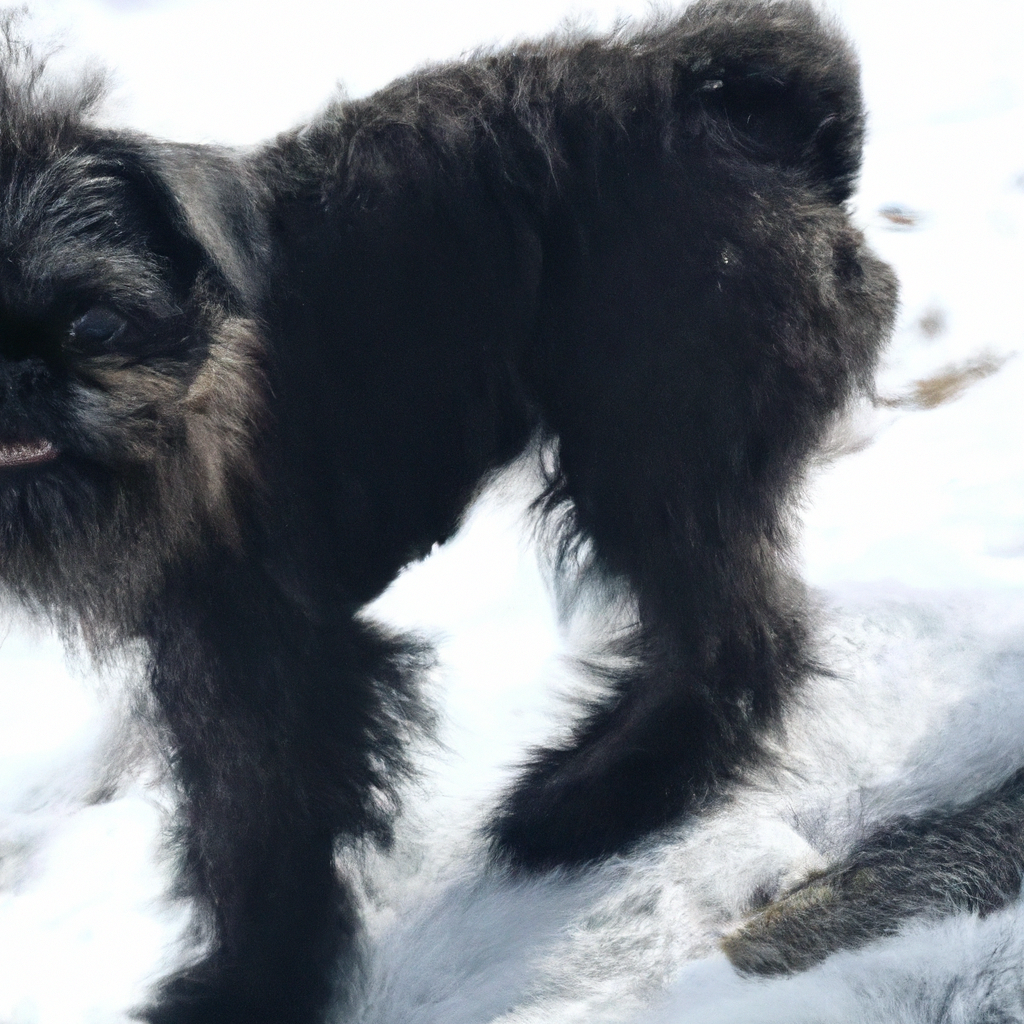Affenpinschers are small, compact dogs known for their distinctive “monkey-like” facial features, hence their name which translates to “monkey terrier” in German. They typically weigh between 6 to 13 pounds and stand about 9 to 12 inches tall at the shoulder. Their dense, rough coat, which comes in colors like black, gray, silver, or red, is typically about 1 inch long on the body, but longer around the eyes, nose, and chin, creating a mane or cape effect. Affenpinschers have a broad, domed skull, short muzzle, and prominent eyebrows and mustache. Their eyes are round, dark, and full of life, while their ears can be either cropped to a point or left natural, in which case they fold over into a neat triangle. The tail is usually docked to approximately two-thirds of its original length. Overall, Affenpinschers are sturdy and well-balanced, with a lively and confident demeanor.
Understanding the Unique Size and Weight of Affenpinschers
Affenpinschers, often referred to as “Monkey Terriers” or “Monkey Dogs” due to their distinct primate-like appearance, are a unique breed of toy dogs that have been capturing the hearts of dog lovers for centuries. Their small size, coupled with their fearless and energetic nature, makes them an ideal companion for those living in apartments or small homes. But what exactly makes the Affenpinscher’s size and weight so unique? Let’s delve into the fascinating world of these little canine wonders.
Affenpinschers are small but sturdy dogs, with a height that typically ranges from 9 to 11.5 inches at the shoulder. This makes them just the right size for a lap dog, but don’t be fooled by their small stature. These dogs are known for their robust and muscular build, which is often hidden beneath their thick, shaggy coat. This gives them a strength and agility that belies their small size, making them excellent at tasks such as catching rats, which was their original purpose in 17th century Germany.
When it comes to weight, Affenpinschers usually tip the scales at somewhere between 6 to 13 pounds. This lightweight nature adds to their charm and makes them easy to carry around, whether you’re taking them on a trip to the park or simply moving them from one room to another. However, despite their light weight, these dogs are far from fragile. Their compact and muscular build gives them a surprising amount of strength and resilience, allowing them to hold their own in play with larger dogs.
One of the most distinctive physical features of Affenpinschers is their coat. They have a dense, rough coat that gives them a somewhat scruffy appearance. This coat is typically black, but can also come in other colors such as grey, silver, red, or tan. The hair on their face is longer than on the rest of their body, resulting in the characteristic “monkey face” that gives them their name. This coat not only adds to their unique appearance, but also serves a practical purpose, providing them with a good amount of insulation against the cold.
Another notable feature of Affenpinschers is their tail. While some Affenpinschers have their tails docked, many are left with their natural tails, which are typically carried high and have a slight curve. This adds to their confident and lively demeanor, and is often a sign of their alert and curious nature.
In conclusion, the Affenpinscher’s unique size and weight, coupled with their distinctive physical features, make them a truly unique breed. Their small stature and lightweight nature make them ideal for those living in smaller spaces, while their robust build and energetic nature ensure they are far from being delicate lap dogs. Whether you’re drawn to their monkey-like faces, their shaggy coats, or their lively personalities, there’s no denying that Affenpinschers are a breed like no other. So, the next time you see one of these little dogs, take a moment to appreciate their unique physical features – they’re part of what makes Affenpinschers so special.
The Distinctive Coat and Color Variations of Affenpinschers
Affenpinschers, often referred to as “Monkey Terriers” or “Monkey Dogs” due to their distinctively primate-like appearance, are a small but mighty breed. One of the most striking features of this breed is their coat, which is as unique as the dogs themselves. The Affenpinscher’s coat is dense, rough, and about an inch long on the body, giving them a shaggy but neat appearance. This isn’t your typical dog fur; it’s more akin to human hair, which is why many people with allergies find they can tolerate Affenpinschers better than other breeds.
The Affenpinscher’s coat is designed to protect them from the elements and from predators. The longer hair on the head, neck, chest, stomach, and legs forms a protective mane and undercoat. This mane, particularly around the head and shoulders, is one of the breed’s most distinctive features, often described as a cape that frames the face, giving the Affenpinscher its characteristic monkey-like appearance.
The hair on the face is longer than the rest of the body, contributing to their unique facial expression. The longer hair around the eyes and nose forms what is known as the “monkey whiskers”, “eyebrows”, and “beard”. These features not only add to their monkey-like appearance but also give the Affenpinscher a comical and endearing expression that is full of character.
Now, let’s talk about color. Affenpinschers come in a variety of colors, adding to their appeal. The breed standard recognizes black, grey, silver, red, black and tan, and beige, which can range from a light cream color to a darker orange-gold. Some Affenpinschers may also have a mixture of these colors, often with a black mask or cape. The most common color is black, but all colors are equally accepted in the breed standard.
It’s important to note that the Affenpinscher’s coat color can change as they age. Puppies are usually born black, and their color lightens as they grow into adults. This is a normal part of the Affenpinscher’s development and something potential owners should be aware of.
The Affenpinscher’s coat requires regular grooming to maintain its distinctive appearance. Despite its rough texture, the coat is not prone to shedding, which is another reason why this breed is popular among allergy sufferers. Regular brushing will help prevent matting and keep the coat looking its best. The Affenpinscher’s facial hair should also be gently combed to prevent tangles and keep their characteristic facial features looking neat.
In conclusion, the Affenpinscher’s distinctive coat and color variations are part of what makes this breed so special. Their shaggy but neat coat, combined with their unique facial features and variety of colors, gives the Affenpinscher a distinctive appearance that is both endearing and full of character. Whether you’re drawn to their monkey-like looks, their hypoallergenic coat, or their vibrant personality, there’s no denying that the Affenpinscher is a breed that stands out from the crowd.
Affenpinschers: A Closer Look at Their Facial Features
Affenpinschers, often referred to as “Monkey Terriers” or “Monkey Dogs” due to their distinct facial features, are a unique breed of toy dogs that originated in Germany. These small, yet sturdy dogs are known for their mischievous personality and their striking physical characteristics. In particular, their facial features are what set them apart from other breeds, making them easily recognizable and incredibly endearing to dog lovers worldwide.
At first glance, the Affenpinscher’s face may seem a bit peculiar, but it’s this very peculiarity that makes them so charming. Their dark, round eyes are full of life and intelligence, often sparkling with a hint of mischief. These eyes, set far apart and rimmed with black, are one of the breed’s most expressive features. They have a way of communicating their thoughts and feelings that is almost human-like, making them a joy to interact with.
The Affenpinscher’s ears also contribute to their unique look. They are typically cropped to a point, standing erect and adding to their alert and curious expression. However, in countries where cropping is not practiced, the ears are naturally rounded and drop forward, framing their face in a delightful way.
The breed’s nose is another notable feature. It’s small, turned-up, and usually black, adding a touch of whimsy to their appearance. The Affenpinscher’s muzzle is short and puckered, often likened to that of a monkey, hence their nickname. This gives them a somewhat comical expression, especially when they reveal their undershot jaw with lower teeth extending beyond the upper ones.
But perhaps the most distinctive feature of the Affenpinscher’s face is their fur. They have a dense, rough coat that gives them a somewhat shaggy appearance. The hair on their face is longer than the rest of their body, particularly around the eyes, nose, and chin, forming a mane or a fringe that frames their face perfectly. This facial hair is often lighter in color, creating a striking contrast against their dark eyes and nose.
The Affenpinscher’s unique facial features are not just for show, though. They serve a practical purpose as well. Their rough coat and longer facial hair protect them from the harsh weather and potential predators. Their dark eyes and black-rimmed eyelids help reduce glare and protect their eyes from the sun. Even their undershot jaw has a purpose, as it was originally developed to help them catch rats and other small vermin.
In conclusion, the Affenpinscher’s facial features are a delightful blend of form and function. They give the breed a unique look that is both endearing and practical. Whether it’s their expressive eyes, their distinctive ears, their turned-up nose, or their shaggy facial hair, each feature contributes to the overall charm of the breed. So, the next time you see an Affenpinscher, take a moment to appreciate their unique facial features. You’ll soon understand why they’re often described as ‘charmingly ugly’ and why they’ve won the hearts of dog lovers around the world.
The Tail and Ears of Affenpinschers: What Makes Them Unique?
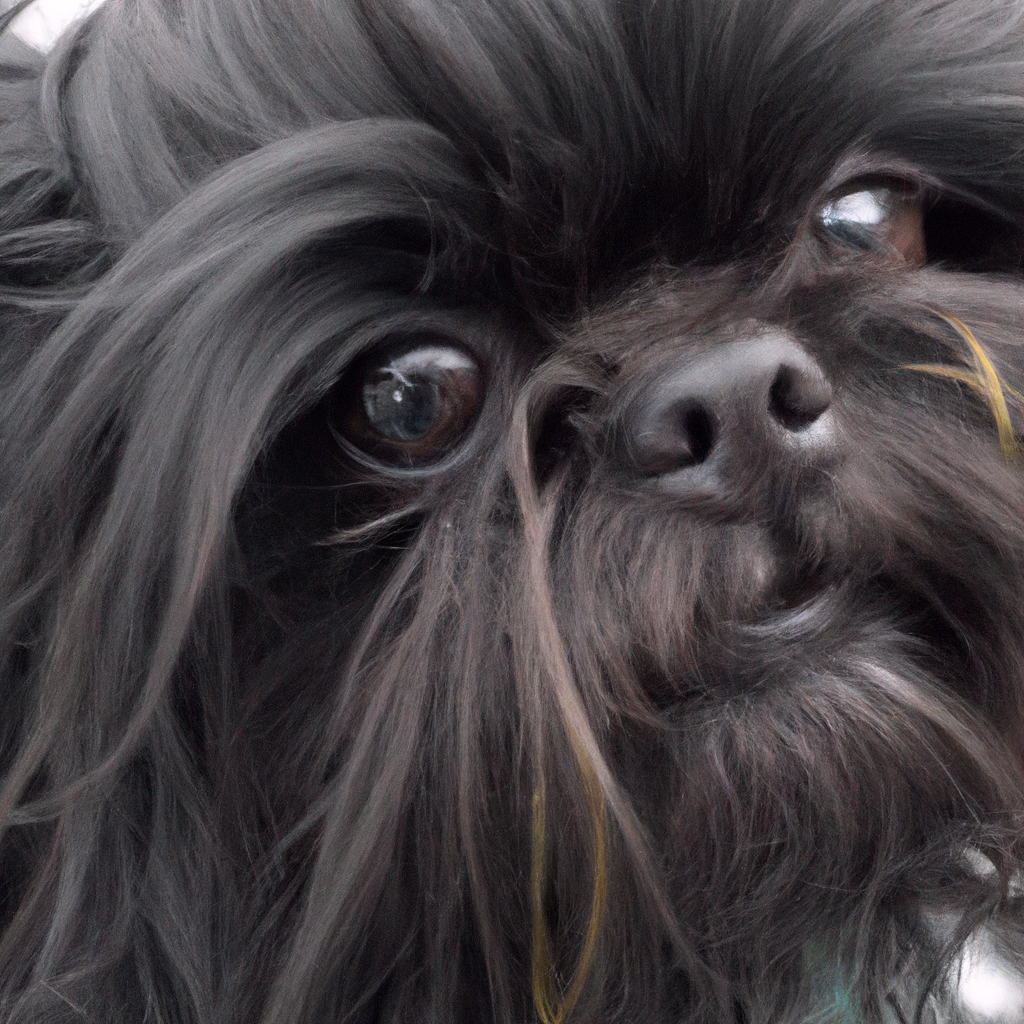
Affenpinschers, often referred to as “Monkey Terriers” or “Monkey Dogs” due to their distinct primate-like appearance, are a unique breed of toy dogs that originated in Germany. They are known for their playful and adventurous nature, but what truly sets them apart are their physical features, particularly their tail and ears. These features not only contribute to their unique appearance but also provide insights into their health and temperament.
The tail of an Affenpinscher is one of its most distinctive features. Traditionally, the tails of these dogs were docked, giving them a short, stubby appearance. This was done for practical reasons, as a long tail could be a liability for a dog bred to hunt rats and other small vermin. However, in many countries, tail docking is now considered inhumane and is either heavily regulated or outright banned. As a result, many modern Affenpinschers have a full tail that is carried high and curves gently over their back. This gives them a lively and alert appearance, reflecting their energetic and inquisitive nature.
The Affenpinscher’s tail is not just an aesthetic feature; it also serves a practical purpose. Like many other breeds, Affenpinschers use their tails for balance and communication. A wagging tail can indicate excitement or happiness, while a tucked tail can signal fear or submission. By observing the position and movement of an Affenpinscher’s tail, you can gain valuable insights into its mood and emotional state.
Just as distinctive as the tail are the Affenpinscher’s ears. These dogs have naturally erect ears that stand high on their head, contributing to their alert and curious expression. The ears are typically small and symmetrical, with a pointed tip. Some Affenpinschers, however, have ears that fold over at the tip, giving them a softer, more rounded appearance. This variation is entirely natural and does not affect the dog’s health or hearing ability.
The Affenpinscher’s ears are not just for show; they also play a crucial role in their communication. Dogs use their ears to express a wide range of emotions, from happiness and excitement to fear and aggression. An Affenpinscher with its ears pricked up is likely alert and interested in its surroundings, while one with its ears laid back may be feeling nervous or submissive.
In conclusion, the tail and ears of an Affenpinscher are not just distinctive physical features; they are also vital tools for communication and balance. By understanding these features, you can better understand and communicate with your Affenpinscher, enhancing your bond with this unique and charming breed. Whether you’re a prospective owner or just a fan of the breed, appreciating the Affenpinscher’s physical features is a key part of appreciating the Affenpinscher as a whole. So next time you see an Affenpinscher, take a moment to admire its tail and ears – they’re more than just cute; they’re a testament to the breed’s unique history and character.
The Muscular Structure of Affenpinschers: A Detailed Overview
Affenpinschers, often referred to as “Monkey Terriers” or “Monkey Dogs” due to their distinct primate-like appearance, are a small but sturdy breed that boasts a unique muscular structure. This breed’s physical features are not only fascinating but also contribute significantly to their agility, strength, and overall health.
Affenpinschers are compact dogs, typically weighing between 7 to 10 pounds and standing about 9 to 12 inches tall at the shoulder. Despite their small size, they possess a surprisingly robust and well-defined muscular structure. This muscularity is a key characteristic of the breed, enabling them to be agile and quick, despite their small stature.
The Affenpinscher’s muscular structure begins with a strong neck that supports their round head and leads to a deep chest. This deep chest houses a large lung capacity for a dog of its size, which is essential for maintaining their energetic and playful nature. The neck muscles are well developed, allowing the Affenpinscher to hold its head high with a proud and confident demeanor.
Moving on to the body, the Affenpinscher has a broad and well-muscled back, which provides a strong foundation for their overall structure. The back muscles are crucial for their agility and quick movements, allowing them to turn on a dime and spring into action with ease. The breed’s short, straight legs are also well-muscled, providing them with the strength and stability they need for their active lifestyle.
The Affenpinscher’s hindquarters are equally muscular, with strong thighs and well-developed hocks. These muscles contribute to their impressive jumping ability, a trait that often surprises those unfamiliar with the breed. Despite their small size, Affenpinschers are known to jump high and with great precision, a testament to their powerful hind leg muscles.
The breed’s muscular structure is covered by a thick, rough coat that adds to their distinctive appearance. This dense fur not only provides protection against the elements but also serves to highlight their muscular physique. The Affenpinscher’s coat is typically black, but can also come in other colors such as grey, silver, red, or black and tan.
The Affenpinscher’s muscular structure is not just for show; it plays a crucial role in their health and longevity. A well-muscled Affenpinscher is typically a healthy one, as the breed’s muscularity helps to prevent obesity and related health issues. Regular exercise is essential for maintaining their muscle tone and overall health.
In conclusion, the Affenpinscher’s muscular structure is a defining feature of the breed, contributing to their agility, strength, and distinctive appearance. This small but mighty breed is a testament to the saying that good things come in small packages. Their robust muscular structure, combined with their energetic and playful nature, makes them a delightful and engaging companion. Whether they’re bounding around the house or showing off their agility in the dog park, the Affenpinscher’s muscular physique is always on display, a testament to the breed’s strength and vitality.
Affenpinschers’ Paws: An Essential Guide
Affenpinschers, often referred to as “Monkey Terriers” due to their distinct primate-like appearance, are a small but sturdy breed that originated in Germany. They are known for their playful and adventurous nature, but one of their most distinctive features is their paws. This article will serve as an essential guide to understanding the unique physical characteristics of Affenpinschers’ paws.
Affenpinschers are small dogs, typically weighing between 6 to 13 pounds, and standing about 9 to 12 inches tall at the shoulder. Despite their small size, they have strong, compact bodies, and their paws are no exception. Their paws are small, round, and compact, with thick pads that provide them with a good grip. This makes them excellent climbers and agile runners, capable of navigating various terrains with ease.
The nails of Affenpinschers are another interesting feature. They are strong and sharp, often appearing black or dark brown in color. These nails are not just for show; they serve a practical purpose. Affenpinschers were originally bred to hunt rats and other small vermin, and their sharp nails were essential tools for digging and catching their prey. Even though most Affenpinschers today live a life of leisure, their nails still retain this strength and sharpness.
The fur on an Affenpinscher’s paws is another distinctive feature. It is typically dense and rough, providing an extra layer of protection against harsh surfaces. This fur can range in color from black, grey, silver, red, to a mix of these colors. It’s not uncommon for the fur on their paws to be a different color than the rest of their body, adding to their unique appearance.
Affenpinschers’ paws are not just physically distinctive; they also play a significant role in their behavior and communication. Like many dogs, Affenpinschers use their paws to communicate with both humans and other dogs. They may paw at their owners to get attention or use their paws to play with other dogs. Observing how an Affenpinscher uses its paws can provide valuable insight into its mood and intentions.
However, it’s important to remember that Affenpinschers’ paws, like the rest of their bodies, require regular care and attention. Their nails should be trimmed regularly to prevent them from becoming too long and causing discomfort. The fur between their pads should also be checked and cleaned regularly to prevent matting and to keep their paws healthy.
In conclusion, the paws of an Affenpinscher are a distinctive and essential part of this breed’s physical features. They are small and compact, with strong nails and dense fur, reflecting their history as vermin hunters. They also play a significant role in their behavior and communication. By understanding and caring for an Affenpinscher’s paws, owners can ensure their pet’s comfort and health, while also gaining a deeper appreciation for this unique and charming breed.
The Role of Genetics in Affenpinschers’ Physical Features
Affenpinschers, often referred to as “Monkey Terriers” or “Monkey Dogs” due to their distinct primate-like appearance, are a unique breed of toy dogs that have captured the hearts of many dog lovers worldwide. Their physical features are not just a result of random chance, but rather a complex interplay of genetics that have been carefully selected and honed over centuries of breeding.
The Affenpinscher’s most striking feature is undoubtedly its face. With round, dark eyes that sparkle with intelligence and mischief, a short muzzle, and a distinctive beard and mustache, the Affenpinscher’s face is often described as having a monkey-like appearance. This is no accident. The breed’s name itself, Affenpinscher, is a German term that translates to “monkey terrier.” This unique facial structure is a result of specific genetic traits that breeders have selected for over the years.
The Affenpinscher’s coat is another distinctive feature shaped by genetics. This breed is known for its rough, shaggy coat that comes in a variety of colors, including black, gray, silver, red, and tan. The texture and color of an Affenpinscher’s coat are determined by a combination of genes, with each color being controlled by a different set of genes. For instance, the gene that controls black coat color is dominant, meaning that if a dog inherits this gene from either parent, it will have a black coat.
The Affenpinscher’s small size is another characteristic that has been influenced by genetics. Affenpinschers typically weigh between 6 to 13 pounds and stand about 9 to 12 inches tall at the shoulder. This small stature is a result of a genetic trait known as dwarfism. In Affenpinschers, this trait has been selectively bred for, resulting in a breed that is small in size but big in personality.
The Affenpinscher’s physical features are not just about aesthetics; they also serve practical purposes. For instance, their rough coat provides protection against harsh weather, while their small size makes them ideal for living in small apartments or houses. Moreover, their distinctive facial features contribute to their expressive nature, allowing them to communicate effectively with their human companions.
However, it’s important to note that while genetics play a significant role in determining an Affenpinscher’s physical features, environmental factors can also have an impact. For example, an Affenpinscher’s diet and exercise routine can influence its weight and overall health. Similarly, grooming practices can affect the appearance of an Affenpinscher’s coat.
In conclusion, the Affenpinscher’s unique physical features are a testament to the power of genetics. Through careful selection and breeding, these small but mighty dogs have been shaped into a breed that is as distinctive as it is endearing. Whether it’s their monkey-like faces, their shaggy coats, or their small stature, each characteristic is a result of a complex interplay of genes. So, the next time you find yourself captivated by an Affenpinscher’s charm, remember that there’s a fascinating story of genetics behind those captivating features.
Affenpinschers’ Lifespan and Health Related to Their Physical Traits
Affenpinschers, often referred to as “Monkey Terriers” or “Monkey Dogs” due to their distinct primate-like appearance, are a small but sturdy breed that originated in Germany. These dogs are known for their unique physical features, which not only contribute to their charm but also play a significant role in their lifespan and health.
Affenpinschers typically stand between 9 to 12 inches tall at the shoulder and weigh between 7 to 10 pounds. Despite their small size, they are known for their robust and sturdy physique. Their compact bodies, coupled with their fearless nature, make them excellent watchdogs. They have a dense, rough coat that is usually black, but can also be grey, silver, red, or a mix of these colors. Their dark, round eyes and bushy eyebrows give them an almost human-like expression, which is part of their unique appeal.
One of the most distinctive physical features of Affenpinschers is their short, pushed-in face. This is a characteristic they share with other brachycephalic breeds like Bulldogs and Pugs. While this trait gives them their unique, endearing look, it can also lead to certain health issues. Brachycephalic breeds are prone to breathing difficulties, overheating, and dental problems due to the structure of their skull. Therefore, it’s essential for Affenpinscher owners to be aware of these potential issues and take necessary precautions, especially during hot weather.
Despite these potential health concerns, Affenpinschers are generally a healthy breed with a long lifespan. On average, they live between 12 to 15 years, which is relatively long compared to other breeds. Their longevity can be attributed to their sturdy physical build and their active lifestyle. Affenpinschers are energetic dogs that love to play and explore, which helps keep them fit and healthy.
However, like all breeds, Affenpinschers are prone to certain genetic health conditions. One of these is hip dysplasia, a condition where the hip joint doesn’t fit together perfectly, which can lead to arthritis in later life. Another common health issue is patellar luxation, where the kneecap can easily slip out of place. Regular vet check-ups can help detect these conditions early and manage them effectively.
Affenpinschers also have a thick, wiry coat that requires regular grooming to keep it in good condition and prevent skin issues. Their coat is hypoallergenic, which makes them a good choice for people with allergies. However, their hair can grow quite long and can cause problems with their vision if not trimmed regularly.
In conclusion, the Affenpinscher’s unique physical features contribute significantly to their overall health and lifespan. While their brachycephalic traits can lead to certain health issues, with proper care and regular vet check-ups, these can be managed effectively. Their sturdy build and active lifestyle contribute to their long lifespan, making them a delightful companion for many years. As with any breed, understanding the Affenpinscher’s physical traits and potential health issues is key to ensuring they live a long, healthy, and happy life.Affenpinschers are small, compact dogs known for their distinctive appearance. They have a rough, shaggy coat, usually black in color, and a unique facial structure with a short muzzle and lower jaw that protrudes slightly. Their round, dark eyes and bushy eyebrows give them an almost human-like expression. They also have a sturdy bone structure despite their small size, and their tail is often docked to a short length. Overall, Affenpinschers are characterized by their monkey-like appearance, which is even reflected in their name, as ‘Affen’ means ‘monkey’ in German.
